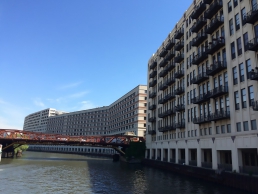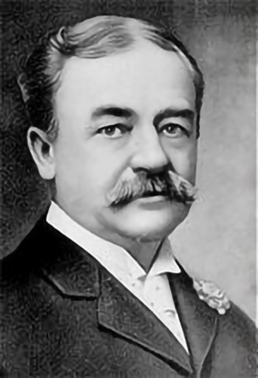MONTGOMERY WARD – ARCHITECTURE AND HISTORY IN ONE PLACE
Here is a Chicago story in one place: The Montgomery Ward & Co. buildings along the north branch of the Chicago River, the company history dating from 1872 and the personal Montgomery Ward story of saving the lakefront.
MONTGOMERY WARD – ARCHITECTURE AND HISTORY IN ONE PLACE
Here is a Chicago story in one place: The Montgomery Ward & Co. buildings along the north branch of the Chicago River, the company history dating from 1872, and the personal Montgomery Ward story of saving the lakefront.

THE BUILDINGS
The three-building Montgomery Ward complex on the north branch of the river is a great place for an architecture lesson, and at the same time represents major Chicago history. The only problem on our river tour is that we first see the buildings from the newest to the oldest, so it seems we are telling the story backward! Plus, there’s a fourth Ward building downtown. Four commercial structures built by one company in 1899, 1907, 1930, and 1974, with new commercial and residential uses today. Nothing else like it in Chicago.
Picture yourself on a boat tour heading north on the North Branch of the Chicago River. We pass Montgomery Ward Park at Erie Street and can see a tall broad blue glass building, edged vertically in stone. No corner windows, an interesting version of modernism. This is “The Montgomery” condominium, once headquarters of Montgomery Ward built in 1974, designed by Minoru Yamasaki, a famous Japanese-American modernist. Yamasaki’s work can be seen throughout the U.S. and from Saudi Arabia to Saskatchewan, but his most famous buildings were the twin towers of the World Trade Center in New York City completed in the early 1970s. His picture was on the cover of Time Magazine in 1963. “The Montgomery” is his only building in Chicago, but he designed the stunning North Shore Congregation Israel temple in suburban Glencoe (1964). Yamasaki died in 1986 at age 74, long before 9/11.

Continuing north, we pass the long riverside of the 1930 Administration Building designed by Wards’ own in-house engineering and construction department under supervision of chief engineer Willis McCauley. After 2000 and the closing of Montgomery Ward & Co., the developers who acquired this building converted it to condominiums, added balconies, carved out a riverwalk and named it “One River Place.” We can see the features of art deco here, with vertical piers and ornament that is flat to the surface and geometric, with the tower entrance at its SE corner. McCauley went on to oversee the building of a number of offices and stores for Wards as the original catalog company expanded into retail across the country, along with its competitor Sears Roebuck. This building features a sculpture atop the tower called artist unknown, a graceful female form.
Cruising beyond the 1914 Chicago Avenue Bridge, we come to the long, low, horizontal drama of the original Wards’ “Catalog Building,” a warehouse and distribution center completed in 1907 by Chicago Prairie School architects Schmidt, Garden & Martin. Additions were built as the company grew, in 1917, 1940 and 1970. This building is in the books if one studies Chicago architecture because it was the biggest reinforced concrete building in the world at the time, and a major Prairie School statement. We can see the dramatic horizontals in ribbons of brick, and can admire the ornament in painted brown terra cotta which reminds us of Frank Lloyd Wright and Louis Sullivan who were in Chicago at the time. Illinois is the Prairie State, with miles of flat land, and the Prairie School style emphasizes the horizontal, clearly represented in this Wards building. Today it houses commercial space, residences, restaurants, and a grand lighted river walk.
The fourth Montgomery Ward building is the first built, in 1899. It overlooks Millenium Park on Michigan Avenue at Madison Street. The “Tower Building” is the first Ward skyscraper designed by Richard Schmidt as a young man. In 1923, a 4-story tower was added to the building by architects Holabird & Roche, topped with a weather vane sculpture of a dramatic female figure by John Massey Rhind, “Progress Lighting the Way for Commerce.” The tower’s original pointed top, weathervane statue and all, was dismantled in 1947 for “safety reasons,” the sculpture cut into pieces, some going to collectors. In 2013, the head of this sculpture was auctioned and sold to a Chicagoan. The Tower Building can be seen in images of Chicago’s skyline taken after 1923, standing taller than all the other buildings lining Michigan Avenue south of the river, Chicago’s “Cultural Mile.”
THE HISTORY

Aaron Montgomery Ward (1844-1913) established the first mail order or catalog company in the country. Born in New Jersey, Ward had many jobs as a young man, and came to Chicago in his 20s after experience in the dry goods industry. Becoming a traveling salesman, Ward noted high prices in the countryside. He became friends of the Grange farmers organization, and began acquiring stock in Chicago for shipment on trains and boats, taking advantage of the country’s RFD program (Rural Free Delivery). No shipping costs! Ward established his namesake catalog company in 1871, the year of the Great Chicago Fire. He began again in 1872, and by the 1890s, was building his skyscraper headquarters on Michigan Avenue (the condominium standing today opposite “The Bean” in Millenium Park). Montgomery Ward’s catalog company was followed by many others, principally Sears Roebuck, but Richard Sears did not come to Chicago until the 1890s, twenty years after Wards began. Sears and Wards competed for over a hundred years, with popular catalogs and later retail stores across the country. Many people remember shopping at “Monkey Wards,” a fond nickname.
SAVING THE LAKEFRONT
Montgomery Ward helped save Chicago’s lakefront. In the early 1900s he looked out from his Tower Building on Michigan Avenue at a mess of buildings and trash in what he knew was supposed to be a park for everyone to enjoy. He began a series of lawsuits which did not make him very popular, but he thought it was the right thing to do. Ward won all of his lawsuits, and Chicago began serious protection of its lakefront, which now boasts 18 miles of paths and sidewalks connecting parks and harbors and beaches. Ward knew Chicago history, that Chicago’s lakefront was to be “Public Ground – A Common to Remain Forever Open, Clear and Free of any Buildings, or Other Obstruction whatever,” as stated on the 1836 map that laid out the canal we had to build to connect the Chicago River to the Des Plaines and Illinois River system, ultimately flowing into the Mississippi above St. Louis. We could not create Chicago until we built that canal, because the far South Branch of the Chicago River was often muddy, an old Indian portage. It was our fortune that the Canal Commissioners added that protective legend on their map. Great reading on this subject is Lois Willie’s Forever Open, Clear and Free, The Struggle For Chicago’s Lakefront, 1972.
Where tour boats turn around at Goose Island, all three Wards buildings are in view, with all three individual characteristics on display – Prairie School, art deco, and modernism – 1907, 1930, and 1974, all typical of the styles popular during those periods of time. We’re reminded of a great American company and a man who contributed greatly to Chicago’s history.
By Judith, Docent for Chicagoline Cruises

THE BUILDINGS
The three-building Montgomery Ward complex on the north branch of the river is a great place for an architecture lesson, and at the same time represents major Chicago history. The only problem on our river tour is that we first see the buildings from the newest to the oldest, so it seems we are telling the story backward! Plus, there’s a fourth Ward building downtown. Four commercial structures built by one company in 1899, 1907, 1930, and 1974, with new commercial and residential uses today. Nothing else like it in Chicago.
Picture yourself on a boat tour heading north on the North Branch of the Chicago River. We pass Montgomery Ward Park at Erie Street and can see a tall broad blue glass building, edged vertically in stone. No corner windows, an interesting version of modernism. This is “The Montgomery” condominium, once headquarters of Montgomery Ward built in 1974, designed by Minoru Yamasaki, a famous Japanese-American modernist. Yamasaki’s work can be seen throughout the U.S. and from Saudi Arabia to Saskatchewan, but his most famous buildings were the twin towers of the World Trade Center in New York City completed in the early 1970s. His picture was on the cover of Time Magazine in 1963. “The Montgomery” is his only building in Chicago, but he designed the stunning North Shore Congregation Israel temple in suburban Glencoe (1964). Yamasaki died in 1986 at age 74, long before 9/11.

Continuing north, we pass the long riverside of the 1930 Administration Building designed by Wards’ own in-house engineering and construction department under supervision of chief engineer Willis McCauley. After 2000 and the closing of Montgomery Ward & Co., the developers who acquired this building converted it to condominiums, added balconies, carved out a riverwalk and named it “One River Place.” We can see the features of art deco here, with vertical piers and ornament that is flat to the surface and geometric, with the tower entrance at its SE corner. McCauley went on to oversee the building of a number of offices and stores for Wards as the original catalog company expanded into retail across the country, along with its competitor Sears Roebuck. This building features a sculpture atop the tower called artist unknown, a graceful female form.
Cruising beyond the 1914 Chicago Avenue Bridge, we come to the long, low, horizontal drama of the original Wards’ “Catalog Building,” a warehouse and distribution center completed in 1907 by Chicago Prairie School architects Schmidt, Garden & Martin. Additions were built as the company grew, in 1917, 1940 and 1970. This building is in the books if one studies Chicago architecture because it was the biggest reinforced concrete building in the world at the time, and a major Prairie School statement. We can see the dramatic horizontals in ribbons of brick, and can admire the ornament in painted brown terra cotta which reminds us of Frank Lloyd Wright and Louis Sullivan who were in Chicago at the time. Illinois is the Prairie State, with miles of flat land, and the Prairie School style emphasizes the horizontal, clearly represented in this Wards building. Today it houses commercial space, residences, restaurants, and a grand lighted river walk.
The fourth Montgomery Ward building is the first built, in 1899. It overlooks Millenium Park on Michigan Avenue at Madison Street. The “Tower Building” is the first Ward skyscraper designed by Richard Schmidt as a young man. In 1923, a 4-story tower was added to the building by architects Holabird & Roche, topped with a weather vane sculpture of a dramatic female figure by John Massey Rhind, “Progress Lighting the Way for Commerce.” The tower’s original pointed top, weathervane statue and all, was dismantled in 1947 for “safety reasons,” the sculpture cut into pieces, some going to collectors. In 2013, the head of this sculpture was auctioned and sold to a Chicagoan. The Tower Building can be seen in images of Chicago’s skyline taken after 1923, standing taller than all the other buildings lining Michigan Avenue south of the river, Chicago’s “Cultural Mile.”
THE HISTORY

Aaron Montgomery Ward (1844-1913) established the first mail order or catalog company in the country. Born in New Jersey, Ward had many jobs as a young man, and came to Chicago in his 20s after experience in the dry goods industry. Becoming a traveling salesman, Ward noted high prices in the countryside. He became friends of the Grange farmers organization, and began acquiring stock in Chicago for shipment on trains and boats, taking advantage of the country’s RFD program (Rural Free Delivery). No shipping costs! Ward established his namesake catalog company in 1871, the year of the Great Chicago Fire. He began again in 1872, and by the 1890s, was building his skyscraper headquarters on Michigan Avenue (the condominium standing today opposite “The Bean” in Millenium Park). Montgomery Ward’s catalog company was followed by many others, principally Sears Roebuck, but Richard Sears did not come to Chicago until the 1890s, twenty years after Wards began. Sears and Wards competed for over a hundred years, with popular catalogs and later retail stores across the country. Many people remember shopping at “Monkey Wards,” a fond nickname.
SAVING THE LAKEFRONT
Montgomery Ward helped save Chicago’s lakefront. In the early 1900s he looked out from his Tower Building on Michigan Avenue at a mess of buildings and trash in what he knew was supposed to be a park for everyone to enjoy. He began a series of lawsuits which did not make him very popular, but he thought it was the right thing to do. Ward won all of his lawsuits, and Chicago began serious protection of its lakefront, which now boasts 18 miles of paths and sidewalks connecting parks and harbors and beaches. Ward knew Chicago history, that Chicago’s lakefront was to be “Public Ground – A Common to Remain Forever Open, Clear and Free of any Buildings, or Other Obstruction whatever,” as stated on the 1836 map that laid out the canal we had to build to connect the Chicago River to the Des Plaines and Illinois River system, ultimately flowing into the Mississippi above St. Louis. We could not create Chicago until we built that canal, because the far South Branch of the Chicago River was often muddy, an old Indian portage. It was our fortune that the Canal Commissioners added that protective legend on their map. Great reading on this subject is Lois Willie’s Forever Open, Clear and Free, The Struggle For Chicago’s Lakefront, 1972.
Where tour boats turn around at Goose Island, all three Wards buildings are in view, with all three individual characteristics on display – Prairie School, art deco, and modernism – 1907, 1930, and 1974, all typical of the styles popular during those periods of time. We’re reminded of a great American company and a man who contributed greatly to Chicago’s history.
By Judith, Docent for Chicagoline Cruises